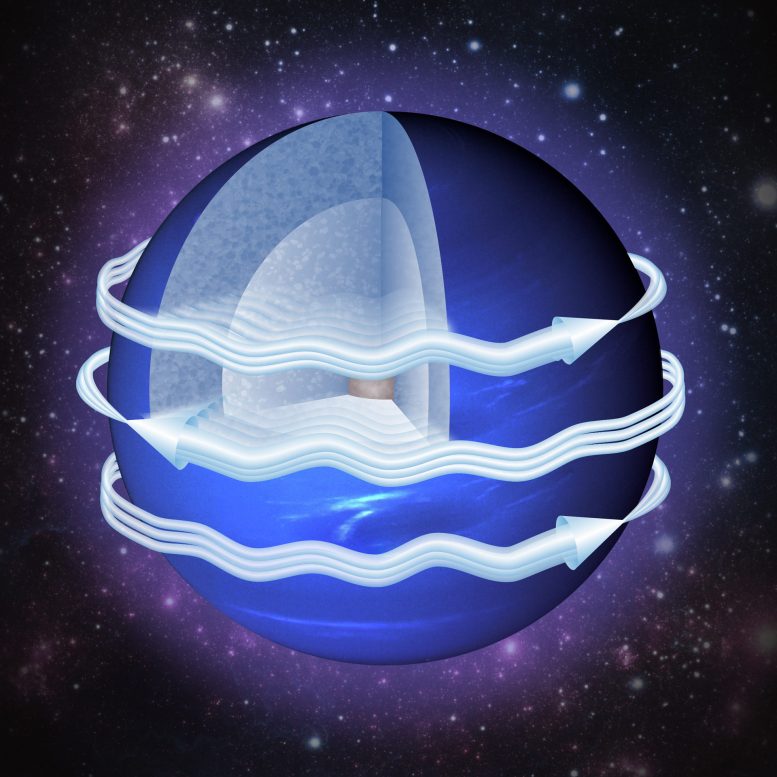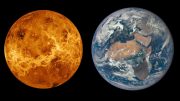
A schematic of the jet streams on the planet Neptune. The atmospheric circulation is characterized by westward flow near the equator and an eastward flow at higher latitudes. Credit: Courtesy of Yohai Kaspi, Weizmann Institute of Science; NASA
In a newly published study, researchers detail the atmospheric circulation patterns of Uranus and Neptune, finding that the streams of gas observed in the atmosphere are limited to a “weather layer” of no more than about 1000 km in depth.
What is the long-range weather forecast for the giant planets Uranus and Neptune? These planets are home to extreme winds blowing at speeds of over 1000 km/hour, hurricane-like storms as large around as Earth, immense weather systems that last for years, and fast-flowing jet streams. Both planets feature similar climates, despite the fact that Uranus is tipped on its side with the pole facing the sun during winter. The winds on these planets have been observed on their outer surfaces; but to get a grasp of their weather systems, we need to have an idea of what is going on underneath. For instance, do the atmospheric patterns arise from deep down in the planet, or are they confined to shallower processes nearer the surface? New research at the Weizmann Institute of Science, the University of Arizona, and Tel Aviv University, which was published online today in Nature, shows that the wind patterns seen on the surface can extend only so far down on these two worlds.
Understanding the atmospheric circulation is not simple for a planet without a solid surface, where Earth-style boundaries between solid, liquid and gas layers do not exist. Since the discovery of these strong atmospheric winds in the 1980s by the Voyager II spacecraft, the vertical extent of these winds has been a major puzzle – one that influences our understanding of the physics governing the atmospheric dynamics and internal structure of these planets. But a team led by Dr. Yohai Kaspi of the Weizmann Institute’s Environmental Sciences and Energy Research Department realized they had a way, based on a novel method for analyzing the gravitational field of the planets, to determine an upper limit for the thickness of the atmospheric layer.
Deviations in the distribution of mass in planets cause measurable fluctuations in the gravitational field. On Earth, for example, an airplane flying near a large mountain feels the slight extra gravitational pull of that mountain. Like Earth, the giant planets of the solar system are rapidly rotating bodies. In fact all of them rotate faster than Earth; the rotation periods of Uranus and Neptune are about 17 and 16 hours, respectively. Because of this rapid rotation, the winds swirl around regions of high and low pressure. (In a non-rotating body, flow would be from high to low pressure.) This enables researchers to deduce the relations between the distribution of pressure and density, and the planets’ wind field. These physical principles enabled Kaspi and his co-authors to calculate, for the first time, the gravity signature of the wind patterns and thus create a wind-induced gravity map of these planets.
By computing the gravitational fields of a large range of ideal planet models – ones with no wind, a task conducted by team member Dr. Ravit Helled of Tel Aviv University – and comparing them with the observed gravitational fields, upper limits to the meteorological contribution to the gravitational fields were obtained. This enabled Kaspi’s team, which included Profs. Adam Showman and Bill Hubbard of the University of Arizona, and Prof. Oded Aharonson of the Weizmann Institute, to show that the streams of gas observed in the atmosphere are limited to a “weather-layer” of no more than about 1000 km in depth, which makes up only a fraction of a percent of the mass of these planets.
Although no spacecraft missions to Uranus and Neptune are planned for the near future, Kaspi anticipates that the team’s findings will be useful in the analysis of another set of atmospheric circulation patterns that will be closely observed soon: those of Jupiter. Kaspi, Helled and Hubbard are part of the science team of NASA’s Juno spacecraft to Jupiter. Juno was launched in 2011; upon reaching Jupiter in 2016 it will provide very accurate measurements of the gravity field of this giant gaseous planet. Using the same methods as the present study, Kaspi anticipates that they will be able to obtain the same type of information they acquired for Uranus and Neptune: namely, placing constraints on the depth of the atmospheric dynamics of this planet.
Uranus and Neptune are the farthest planets in the solar system, and there are still many open questions regarding their formation and composition. This study has implications for revealing the mysteries of their deep, dark interiors, and may even provide information about how these planets were formed. Moreover, many of the extrasolar planets detected around other stars have been found to have similar masses to those of Uranus and Neptune, so this research will be important for understanding like-sized extrasolar planets, as well.
Reference: “Atmospheric confinement of jet streams on Uranus and Neptune” by Yohai Kaspi, Adam P. Showman, William B. Hubbard, Oded Aharonson and Ravit Helled, 15 May 2013, Nature.
DOI: 10.1038/nature12131









Weather layer of ringed planets like Uranus and Neptune seem to be common. The only ideal condition happens to be a giant planet surrounded by atomosphere where streams of gases collect to form a ring around their equator. Moreover, the linear velocity of the equator is very high in these giant planets to cause a gaseous stream to flow, through, because of their large spin rotation speeds. Apart from the innumerable planetoids and satelites circling around these Gas giants like Jupiter and Saturn and also Uranus and Neptune, it is the gaseous stream that is responsible for the gaseous ring around all these gas giants probably, which we infer from this article. Thank You.